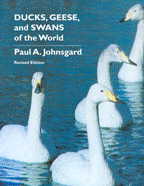Papers in the Biological Sciences

Ducks, Geese, and Swans of the World by Paul A. Johnsgard
Date of this Version
2010
Document Type
Book Chapter
Abstract
Black-headed Duck
Masked Duck
Ruddy Duck
White-headed Duck
Maccoa Duck
Argentine Blue-billed Duck
Australian Blue-billed Duck
Musk Duck
The stiff-tailed ducks are characterized by several unusual features in addition to their long, stiffened tail feathers that serve as underwater rudders. Among other adaptations are their very large feet, which are placed so far back on the body that it is difficult for these birds to walk on land. The body feathers are small, numerous, and have a grebe-like sheen, and the wings are so short that takeoff and flight is attained with difficulty. All of the species have relatively short and thick necks, which in males can be enlarged by the inflation of various internal structures during sexual display. Although all of the species exhibit some dimorphism of size or coloration, the plumage patterns are mostly shades of gray, ruddy brown, and black, with contrasting white markings largely limited to the head. Only one species, the masked duck, exhibits a distinct speculum, and this species is furthermore the only one that is able to attain flight easily. The downy plumage patterns are usually very similar to those of the adult females, which tend to be inconspicuously patterned with grays and browns. Nonbreeding plumages of males also closely resemble those of the females, and during this period the ruddy coloration of the typical forms is largely lost, as is the unusual blue color of the male's bill. Two species that do not fit this general pattern are the Australian musk duck and the South American black-headed duck. The musk duck may readily be considered a typical stiff tail that, under evolutionary pressures associated with a highly competitive mating system favoring strength and aggressiveness, has become remarkably large and has evolved bizarre male displays. However, the black-headed duck lacks many of the traits of the stiff-tailed ducks, and in many anatomical features more closely approaches the dabbling ducks. In addition to providing an apparent evolutionary link with that group, the black-headed duck is also the only species of Anatidae that seems to have become a total social parasite, abandoning its nest-building tendencies in favor of dropping its eggs in the nests of a variety of host species. In this sense it is one of the most specialized of all waterfowl species, although its parasitic adaptations are relatively primitive by comparison with those of some of the better-known species of social parasites.


Comments
In Ducks, Geese, and Swans of the World, by Paul A. Johnsgard. Electronic edition copyright © 2010 Paul A. Johnsgard.